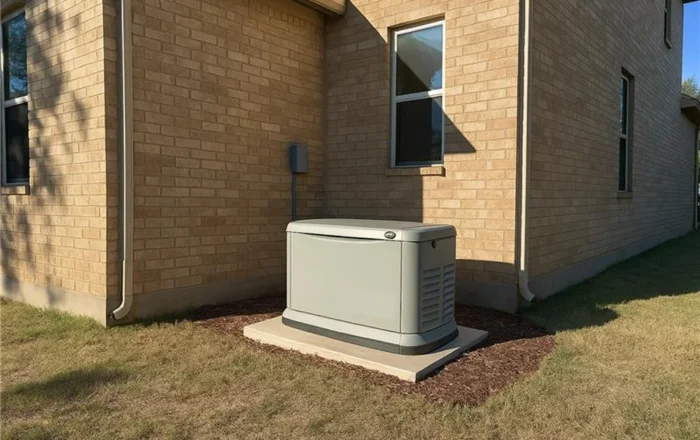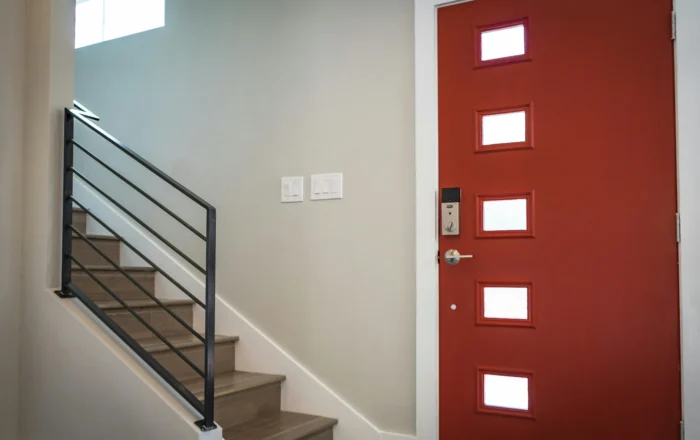How to Choose a Generator for Your Home
6 minute readHow to choose the right generator for your Texas home
Home > BKV Energy Blog > All Posts > How to Prevent Frozen Pipes
How to prevent your pipes from freezing and what to do when if they do freeze
4 minute read • Last update December 2024

As the Texas winter weather sets in, some of the most common questions homeowners ask are about how to prevent pipes from freezing and how to thaw frozen pipes. After all, whether it’s an unexpected cold snap or a forecasted winter storm, freezing temperatures can cause some pretty serious damage.
But don’t panic. With the proper precautions, you can get ready for the cold weather and protect your home and family. In this handy guide, we’ll explain:
Read on to prepare for the next cold spell like a pro!
Let’s start with the basics: when to worry about pipes freezing. Most people are aware that water freezes at 32°F (0°C). But at what temp do pipes freeze, and is there a minimum temperature to keep pipes from freezing?
The water in your pipes and supply lines is more insulated than free-flowing water, so it tends not to freeze until the temperature drops to around 20°F (-6°C) or below. Even then, the effect won’t be instant, as it takes 3-6 hours of exposure for water supply lines to freeze completely.
However, some pipes are more susceptible to freezing than others. For example, exposed pipes located in basements, attics, crawl spaces, or along exterior walls are particularly vulnerable.
Thankfully, preventing frozen pipes doesn’t require you to run your heating system at full blast.
In fact, many of the most effective methods focus on how to keep pipes from freezing without heat so you can still manage your energy consumption effectively and reduce your winter electric bill.
Follow these steps to prevent pipe freezing and safeguard your home and loved ones from the cold.
Water pipes with little or no insulation are more likely to freeze. Choosing the correct type of pipe insulation helps keep heat around the pipes, even when the cold air sets in.
Even if you’re away, it’s recommended to set your thermostat to at least 55°F to maintain a steady flow of warm air around your water lines.
Letting faucets drip is lesson 101 in how to protect pipes from freezing. Even if it’s only a trickle, keeping water moving reduces the chance of freezing, especially for outdoor hose bibs and any pipes connected to an exterior wall.
Cold water pipes hidden behind kitchen and bathroom cabinets can solidify quickly. Opening the doors allows warmer air to circulate, preventing frozen pipes that could cause significant damage if they burst.
Air leaks around windows, doors, and pipes are entry points for the cold. Sealing cracks and gaps with caulk or weather stripping ensures that the warm air stays in and cold air is kept out.
Disconnect garden hoses and sprinkler systems and drain the water from them before winter sets in to avoid residual water from freezing inside them and causing damage while they’re not in use.
Wrapping pipes in cold and vulnerable areas with heat tape or applying pipe heating cables is a simple yet cost-effective way to keep them warm enough to prevent freezing.
If your garage is attached to your home, keeping the doors closed will keep your pipes warm by blocking out freezing air that would otherwise infiltrate your system much quicker.
Any water residue could freeze over the cold winter months, causing internal damage that won’t become apparent until you need to start using them again.
Learning how to prevent frozen pipes is essential, yet doubt can still creep in from time to time. Even the best-laid defenses might not withstand a particularly severe cold spell.
Not sure if your pipes have already frozen? Here are some telltale signs to watch out for:
If you notice any of these issues with your pipes, frozen water may already be causing internal damage, so it’s essential to act swiftly to minimize damage.
Knowing what to do if your pipes are frozen ensures you can act quickly to melt ice buildups and get the water flowing again. Here are the steps to follow:
Following these steps could save you hundreds or even thousands of dollars in damage and repairs.
Knowing how to prevent frozen pipes isn’t the only way to prepare for the winter months. Choosing the right electricity plan is also a proven way to save money and keep your home and family warm.
At BKVE, we know that every little bit counts when it comes to saving energy. That’s why we keep our homeowner electricity plans simple, straightforward, and gimmick-free.
Try our Bluebonnet plan for 30 days risk-free, and see how much you can save!
Graham Lumley, Digital Marketing Manager at BKV Energy, leads digital and traditional marketing strategies, focusing on educating Texans about the state's deregulated energy market. With over 8 years of marketing experience, he creates content to help consumers understand and save on their energy bills, bringing a fresh and dynamic approach to the industry.

How to choose the right generator for your Texas home

Energy Saving Tips Home Improvement
Choosing the right energy-efficient door can help Texas homeowners reduce cooling costs and improve home comfort year-round.
Get $50 off your electric bill!
Use code BKVEJOINUS50
Enter your zip code to shop BKV Energy's affordable, fixed-rate Texas electricity plans. Use the promo code for $50 off your electric bill.